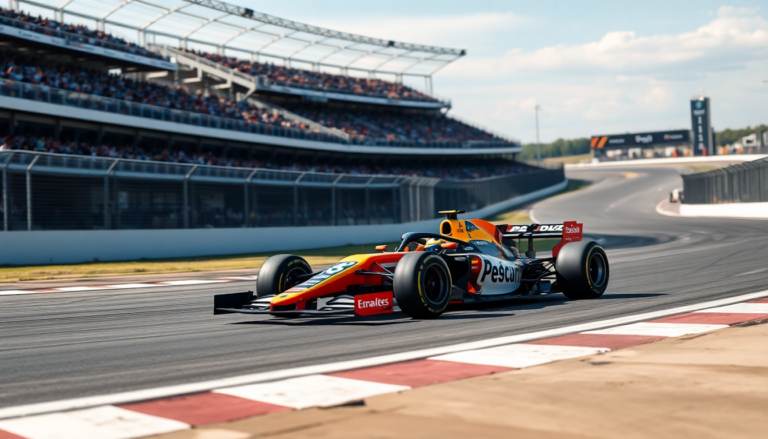Argomenti trattati
When you think of Formula 1 racing, what comes to mind? Intricate circuits with a mix of right and left turns, elevation changes, and a variety of track surfaces, right? Now, contrast that with oval tracks, where cars typically turn in just one direction. This difference presents a unique set of challenges that require different engineering approaches. Understanding these distinctions not only highlights how specialized both types of racing are but also sheds light on the specific demands each places on the vehicles competing on them.
Design and Performance Considerations
The design of Formula 1 cars is primarily tailored for street and mixed circuits, like the iconic Monaco or the challenging Spa. These tracks feature a blend of tight corners, long straightaways, and elevation changes. To tackle this mix, F1 cars need to generate significant aerodynamic downforce to maximize traction. That’s where the advanced front and rear wings come into play, meticulously engineered to help cars navigate these varied track layouts effectively. Isn’t it fascinating how every detail is crafted for performance?
Now, let’s shift gears to oval tracks, such as the legendary Indianapolis Motor Speedway, known for its IndyCar races. Here, the game changes entirely. On these tracks, stability at high speeds is crucial, so the aerodynamic load must be perfectly balanced to minimize drag while still maintaining blistering speeds—often exceeding 300 km/h. This requires a unique setup, potentially featuring smaller or differently angled wings, ensuring that vehicles can handle sustained high-speed turns without losing their footing.
But there’s more. The continuous curves on oval tracks create an asymmetric load distribution on the vehicles. Unlike IndyCars, which are designed to handle these dynamics, Formula 1 cars face a tough challenge. With their typically rigid suspension systems designed for smoother surfaces, they struggle to adapt to the varying demands of a banked oval layout, which can range from 9° to 33°. How does that affect performance? It’s a question worth pondering!
Tire and Engine Adjustments
Tires play a crucial role in this equation too. Pirelli, the tire supplier for Formula 1, crafts compounds that optimize grip and durability for the diverse asphalt of road courses. However, on an oval track, where forces predominantly act on one side of the car—like the right side at Indianapolis—the tires face extreme stress that they aren’t specifically tested for. This can lead to rapid overheating or degradation, which can significantly impact both performance and safety. Would you feel comfortable racing under those conditions?
And then there’s engine performance. The hybrid power units in Formula 1, equipped with 1.6L V6 turbo engines, are designed for frequent acceleration and deceleration. However, maintaining efficiency on an oval can be a different story. These vehicles need to sustain high speeds, which calls for different transmission settings that favor longer gear ratios. It’s clear that the unique demands of oval racing could limit the hybrid systems’ effectiveness, prompting a reevaluation of engine tuning and power delivery strategies.
A Historical Perspective and Safety Considerations
Looking at history, Formula 1’s flirtation with oval racing has been quite limited, with the Indianapolis 500 being a notable exception when it was part of the championship calendar from 1950 to 1960. During that era, F1 cars weren’t really competitive against purpose-built Indy cars. The differences in design philosophy and engineering priorities meant that European teams often stayed away, leaving the field open for American manufacturers to dominate the event.
Safety, of course, is a top concern when considering Formula 1 vehicles on oval tracks. High speeds—often reaching 350-380 km/h—pose a risk of catastrophic collisions, especially against concrete barriers. While modern ovals are equipped with safety features like SAFER barriers, developed for cars such as IndyCars and NASCAR, there’s no guarantee they would provide the same protection for the lighter, carbon-fiber chassis of an F1 car. The introduction of safety innovations like the Halo device has improved driver protection, but the inherent risks of oval racing remain significant. Would you feel safe in that kind of environment?
In conclusion, while it’s theoretically possible for Formula 1 cars to adapt to oval racing, the substantial modifications required would likely compromise their performance on traditional circuits. The complexities of engineering, safety, and the distinct racing philosophies firmly set Formula 1 apart from oval-centric categories like IndyCar or NASCAR. As F1 continues to extend its reach in the United States, we’re left wondering: will hybrid circuits that incorporate oval elements emerge? For now, a full pivot toward oval racing seems unlikely. What do you think the future holds for this thrilling sport?

